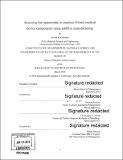Assessing the opportunity to produce Nitinol medical device components using additive manufacturing
Author(s)
Kalidindi, Arvind R.(Arvind Rama)
Download1119387174-MIT.pdf (9.847Mb)
Other Contributors
Sloan School of Management.
Advisor
Thomas Roemer and Christopher A. Schuh.
Terms of use
Metadata
Show full item recordAbstract
Nitinol is an important alloy for medical device applications due to its exceptional combination of strength and elasticity. Most Nitinol is produced in wire form and then braided or laser cut into the complex geometries needed for medical device applications. These manufacturing processes are costly and can be labor-intensive. Additive manufacturing, or 3D printing, offers a tantalizing alternative to the status quo of Nitinol manufacturing as the desired part can be printed to shape, greatly simplifying the operations and cost of producing medical device components. Working with Boston Scientific in Clonmel, Ireland, roughly 100 Nitinol samples were additively manufactured to determine whether quality parts could be printed. Through a design of experiment procedure, the 3D printing parameters were optimized to develop settings for parts with high relative density, low internal defects, and low impurity concentrations, meeting the ASTM F2063 standards for medical device-grade Nitinol. The main challenge from an engineering perspective is the loss of Ni during printing, which could require either higher power lasers or sourcing high Ni content powder to reach the desired properties. Operationally, a cost accounting model was developed to match the expected operational setup for additively manufacturing Nitinol, with smaller components comparing favorably cost-wise to traditionally manufactured Nitinol components. The engineering and business analyses were combined to determine the best applications considering Nitinol properties used (superelasticity, shape memory, and ductility) and the opportunity for 3D printing (prototyping, replacing existing Nitinol parts, developing new Nitinol parts). The best opportunities in the short-term for this technology were identified to be prototyping and developing new Nitinol components targeting ductility and shape memory Nitinol applications.
Description
Thesis: M.B.A., Massachusetts Institute of Technology, Sloan School of Management, 2019 Cataloged from PDF version of thesis. Includes bibliographical references (pages 64-69).
Date issued
2019Department
Sloan School of ManagementPublisher
Massachusetts Institute of Technology
Keywords
Sloan School of Management.